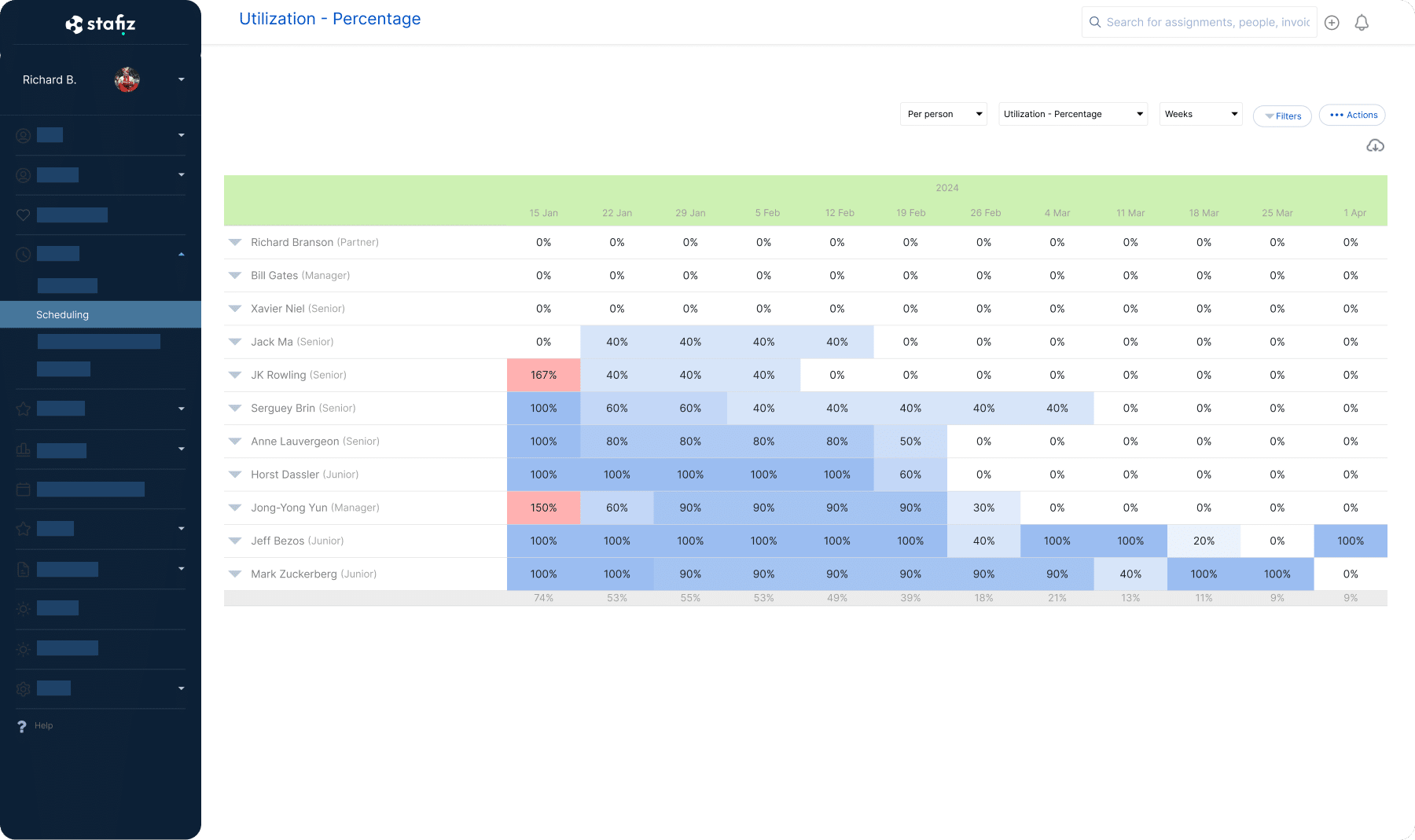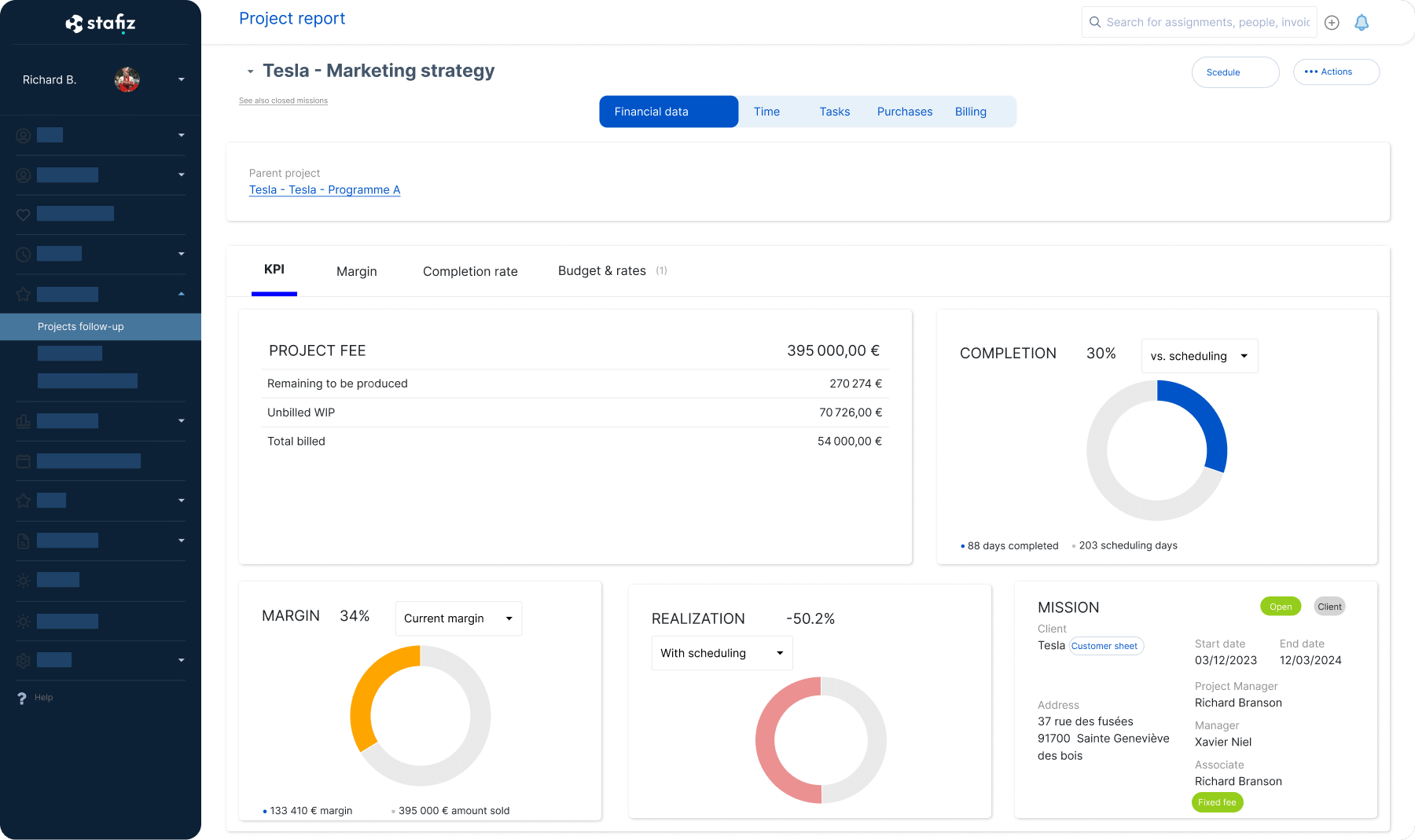What is resource capacity planning in project management?

You’ve heard it said that failing to plan is planning to fail…but planning isn’t always easy. Do you have enough people assigned to projects at any given moment? Will you still have enough people if the requirements of the project change? And what about planning for the other factors involved, such as ? Changes in exchange rates that may impact global projects?
Resource capacity planning - without the assistance of intelligent software - is nearly impossible. In professional services organisations, for example, the number of workers you’ll require to deliver on projects will shift constantly. You’ll need different skill sets, costs, time commitments and a different number of employees for each project.
Then you have to remember that human resources are just one piece of the puzzle. Operational needs will change over time - temporarily and permanently. Some projects require adaptive planning as priorities change, work delivery varies, and benefits are realised.
If you want to effectively deliver on projects, you’ll need to manage all of these variables by adopting an integrated, data-driven approach that considers the whole picture - instead of considering a single resource in isolation. Every variable has to be considered in a holistic way, taking into account the different factors that have an impact on the workforce and the project.
Resource capacity planning: definition
Resource capacity planning is a strategic process that organisations use to ensure they have the right resources (such as personnel, equipment, technology, and facilities) in the right place at the right time tomeet their business objectives. This planning helps organisations optimise their resources, avoid bottlenecks, and improve overall efficiency.
This planning helps organizations optimize their resources, avoid bottlenecks and improve overall business productivity.
In other words, resource capacity planning is how businesses and project managers leverage resources to achieve their goals.
As you can tell by the name, resource capacity planning is a combination of capacity planning and resource planning. While those two terms are often used interchangeably, they are slightly different.
The specifics of capacity planning
Capacity planning focuses on the system or infrastructure as a whole, and its ability to handle demand. It looks at things like server capacity, network bandwidth, or storage space.
Resource planning details
Resource planning is the tactical execution of capacity planning. It's about taking your your available resources and using them to their full potential to achieve specific project goals. These resources could be people, equipment, tools, materials, or even budget. During resource planning, you’ll assign the best people and tools to specific tasks and ensure that they are scheduled correctly so that your teams are used optimally and projects are completed timeously.
Capacity planning often takes a broader, long-term view, considering future growth and strategic goals. Resource planning focuses on a shorter time frame, typically aligned with project schedules or business cycles.
Resource planning focuses on a shorter time frame, usually aligned with project schedules or business cycles.
Organizational effectiveness in resource management is about finding the perfect balance – ensuring there are enough resources available, used optimally for the duration of your project.
Discover the guide to efficient resource management
The benefits of resource capacity planning
So why invest inresource capacity planning? There are numerous benefits, including the ability to:
Improved project management and resource allocation
Resource capacity planning allows organisations to identify underutilised resources and allocate them more efficiently. By analysing capacity data, businesses can ensure that their teams are fully utilised, minimizing idle time and maximizing productivity.
This leads to optimal resource utilisation without the need for additional hiring, contributing to cost-effectiveness and efficiency.
Forecasting resource needs and filling the skill gap to avoid shortages
Capacity planning helps forecast skills demand accurately, allowing organisations to identify potential skill gaps.
By having a clear understanding of the required skills for upcoming projects through a skills gap analysis, businesses can take proactive measures to fill these gaps, whether through workforce training and development or hiring new talent.
This prevents shortages of the right resources, reducing the need for last-minute, expensive hiring measures.
Organisational culture and resource management go hand-in-hand as better organisation of resources reduces burnout and stress .
Ensure the right teams for cost, delay, and quality
By incorporating resource capacity planning into day-to-day operations, organisations ensure that the right teams are assigned to projects.
This alignment of skills and availability leads to better project outcomes, as teams can deliver high-quality work within the specified timelines and budget.
This doesn’t just enhance client satisfaction, but also helps control costs and avoid delays.
Win more projects and clients!
Ultimately, companies that plan more effectively will win more projects and more clients in the long-term. Resource capacity planning enables businesses to respond quickly to project opportunities.
By having a clear view of available resources and their capacities, organisations can confidently commit to new projects, knowing they have the necessary skills on hand.
By having a clear view of available resources and their capacities, organisations can confidently commit to new projects, knowing they have the necessary skills on hand.
This agility in responding to opportunities enhances the chances of winning more projects and clients. The emphasis on high-quality deliverables ensures client satisfaction and strengthens the business's reputation.
Anticipate your activity management by integrating the management of your sales opportunities into your project management tool. Pre-position your teams, adjust the forecast workload, and rapidly create your projects once the opportunity has been won.
Align sales and projects
Capacity planning facilitates alignment between sales and project teams. Sales teams can make realistic promises to clients based on the available resources and their capacities.
This alignment ensures that the commitments made during the sales process are achievable, preventing overcommitment and subsequent resource shortages.
It leads to a more synchronized workflow, improving overall project success rates.
The challenges associated with resource capacity planning
The challenges of resource capacity planning are not solved simply by acquiring new software. Some of the same problems may arise.
The challenges of resource capacity planning are not solved simply by acquiring new software. Some of the same problems may arise.
Lack of visibility and communication capabilities
Inadequate communication channels and visibility into the evolution of scheduling and priorities can lead to misalignments between teams. If teams don’t have visibility, your project may experience delays, overcommitments, and conflicts in resource allocation.
It's important to develop communication strategies in resource planning from the get-go.
The Stafiz platform integrates key capacity planning functions for service companies: multi-criteria search for internal or external profiles, management of needs and degrees of suitability.
Skills gap and training needs
You may not have the skills within your organisation to meet the needs of a client or project. But identifying skill gaps and training needs is challenging without a comprehensive understanding of the current skill set within the organisation.
Maybe you have the right resources in the organisation, but they’ve been allocated elsewhere - perhaps even where they aren’t needed. This may lead to allocating resources ineffectively, or underutilizing resources, or even becoming over-reliant on the same expensive external hires.
Lack of integration of load forecasting
Effective resource capacity planning isn’t just about planning for the moment. Which resources will you need in the future? Can you, for example, replace a senior with two juniors to free them up for more pressing or important projects?
Any lack of integration between forecasting and resource capacity planning can result in poor alignment with project demands, leading to under or over-allocation of resources.
Forecasting future resource needs is challenging without a clear understanding of upcoming projects and business growth, ultimately leading to resource shortages or excess capacity.
Lack of data for informed decision-making
Many of these issues come down to the same thing: inadequate data on resource usage, project progress, and historical performance.
This often sends project teams scrambling, increasing project risk and leading to reactive decision-making and sub-optimal resource allocation.
Key Elements / steps in resource capacity planning
The good news is that these issues can be managed effectively by following simple but key steps:
Step 1: track resource availability for the future
Resource capacity planning begins with a comprehensive understanding of the available resources and their anticipated utilisation in the upcoming weeks and months. You will need to identify and analyse upcoming projects to determine their resource requirements. This includes understanding the skills, expertise, and profiles needed for each project.
Next, categorize resources based on skills roles, and expertise. This helps in aligning the right resources with specific project demands. Use historical data, market trends, and project forecasts to project the demand for resources over the next weeks or months. This projection should consider the varying needs of different projects.
Finally, conduct an assessment of availability for the period. This involves assessing current workloads, ongoing commitments, and planned leaves or absences.

You can also facilitate a much faster match between project requirements and available expertise and respond more quickly to new project opportunities, demonstrating agility in the competitive market.
The right tool can provide a snapshot that indicates availability, overutilization or potential gaps at a glance. The visual representation should highlight available resources, their skills, and any potential gaps in the workforce, facilitating quick and strategic decision-making.
This quick view enables decision-makers and project managers to make rapid, informed decisions, ensuring that critical resources are allocated efficiently and projects are adequately staffed.
If you can quickly anticipate and identify potential resource shortages in advance, you are able to take proactive measures, such as hiring, training, or redistributing tasks. This not only helps you deliver on your promises, but aligns the entire workforce with the specific needs of upcoming projects overall project success rates.
Step 2: Estimate resource demand
After tracking resource availability, the next critical step in resource capacity planning is estimating resource demand. This involves creating a comprehensive plan and budget for projects, outlining the specific resource requirements to meet project objectives.
Initiate the forecasting process as early as the sales stage. Collaborate with the sales team to gather information on potential projects and their resource needs.
Next, take financial considerations into account during your resource demand estimation. Develop scenarios that account for varying costs, helping to create a more accurate budget for resource allocation.
Look backwards as well as forwards. Dive into the details of previous projects to understand what worked well and what didn't. Analyse tasks that took more time than anticipated and learn from past deviations to improve future resource planning. Implement time-tracking mechanisms to analyse costs and time spent on projects and conduct a deviation analysis to compare actual performance with planned objectives. This analysis can be done at both project and individual profile levels.

Step 3: Centralize demand and collaborative resource planning
Finally, make sure to define your resource needs and Centralise the demand for various profiles and skills required for upcoming projects. Identify the right profiles, considering skills, availability, and individual preferences and foster collaboration in resource planning by involving team members in the decision-making process.
Allow colleagues to choose projects and express their preferences for specific skills or tasks.
Organise your resources across projects and over time to avoid silos within the organisation, taking the broader organisational needs into account.

How to choose a resource optimization tool?
With a myriad of tools available, how do you choose the best one? Several additional factors should be taken into account to ensure that the software you select meets the specific needs of the organisation. Here are key considerations:
Profitability aspects and budgeting
Evaluate the tool's ability to facilitate budgeting and profitability analysis. A robust resource capacity planning tool should allow for the creation and management of budgets, helping your organisation align resource allocation with financial goals.
Tracking financial KPIs ensures that resource planning aligns with overall financial objectives, allowing for better decision-making and performance evaluation.
Time tracking capabilities
Verify the tool's time tracking capabilities for accurate measurement of resource usage.
Time tracking is essential for analysing project costs, identifying areas for improvement, and ensuring that resources are allocated efficiently.
Management of internal and external resources
Many projects involve a mix of internal and external contributors. A comprehensive tool should facilitate the seamless integration and management of resources from internal and external sources.
The tool should also integrate its resource planning and management capabilities with other critical processes, such as sales/opportunities, HR, and billing. For example, integration with sales processes ensures that resource planning aligns with project opportunities, while HR integration supports workforce management.


